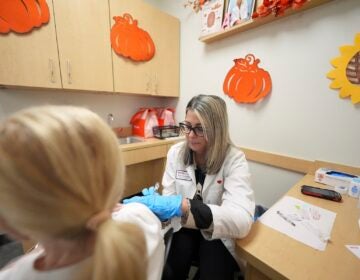Scientists warned us about monkeypox in 1988. Here’s why they were right.

Smallpox vaccines being administered in Paris in 1941. When the disease was eradicated and vaccination came to a stop, that created an opening for its virus relative monkeypox. (Roger Viollet via Getty Images)
Back in 1988, scientists in London almost seem to have had a crystal ball.
Writing in the International Journal of Epidemiology, they made a bold – and surprisingly prescient – prediction about monkeypox: Over time, “the average magnitude and duration of monkeypox epidemics will increase,” they wrote.
At the time, monkeypox was an extremely rare disease. Health-care workers detected only a few cases a year in West and Central Africa. People caught the disease almost exclusively from rodents or primates and then spread the virus to only a few people. Transmission between people was limited.
But the foresighted scientists warned that, over time, these sporadic outbreaks would grow in size and spread geographical. “In every monkeypox paper on previous outbreaks, there’s always a warning about how we need to prepare for more outbreaks in the future,” says infectious disease doctor Boghuma Titanji of Emory University. “That prediction has actually borne out.”
Back in the 1990s, there were only about 50 monkeypox cases a year in West and Central Africa. Jump ahead 20 years, and in 2020, there were likely more than 5,000 cases, scientists reported in February.
Now, in 2022, the world is facing the first international outbreak of monkeypox, with more than 450 cases reported in about 20 countries. Many scientists believe additional cases are going undetected, and the virus is likely spreading in communities where monkeypox has never spread before.
So how did the scientists in London know, way back in 1988, that monkeypox was going to eventually surge?
The smallpox connection
“What we’re seeing now is a result of the greatest achievement in public health. That is the eradication of smallpox,” says epidemiologist Anne Rimoin of the University of California, Los Angeles.
Smallpox is one of the deadliest diseases in human history. The highly contagious virus kills up to 30% of the people infected. By comparison, the version of monkeypox in this outbreak kills less than 1% of people infected.
“So monkeypox, in all of its iterations, is much less severe than smallpox,” Rimoin says.
Through a massive vaccination campaign, the world officially eliminated smallpox in 1980. That achievement saved millions of lives each year.
But as Rimoin explains, the end of smallpox had a repercussion: It opened the door for monkeypox to emerge, possibly worldwide.
“Of course, we’re going to see other viruses emerge that may fill that void or that niche. And that’s what we’re seeing,” she says.
So why has monkeypox been the virus to fill that void? It’s because of what’s known as cross-immunity.
Monkeypox is closely related to smallpox. They’re both in the same virus family. Having a smallpox infection – or a smallpox vaccine– offers really good protection against smallpox as well as monkeypox. Perhaps about 85% protection, one study estimated. In other words, protection against smallpox, also cross-protects against monkeypox.
So back in the 1970s, essentially the entire world’s population had some immunity to monkeypox, says epidemiologist Jo Walker of the Yale School of Public Health. Most people were either vaccinated for smallpox or survived an infection.
“Smallpox is a really old disease,” Walker says. “Most people were infected, at some point in their lives, often in childhood, or they were vaccinated. So in a sense, here was a lot of immunity in the population to this family of viruses [40 years ago].”
But then in the late 1970s, the world stopped vaccinating people for smallpox. And people, thankfully, stopped getting infected. So over the past four decades, immunity to smallpox – and monkeypox – has dropped precipitously.
“So over time, new babies were born and they didn’t get the vaccine and they didn’t get infected with smallpox,” Walker says. “Many of the older people who were vaccinated for smallpox or had an infection have died.”
As a result, now the world’s population has very little immunity to monkeypox. “We’re actually at a point where population immunity against monkeypox is the lowest it’s been in basically thousands of years,” they say.
Without some immunity, people are more likely to catch monkeypox from an animal and spread it to someone else. So an outbreak in West Africa that would have been small in the 1990s is much bigger today. And the chance for it spilling into other continents has risen.
Since immunity in the population won’t rise substantially in the near future, these international outbreaks of monkeypox will likely become more common with time.
Now there is a vaccine for monkeypox. Vaccinating people who have come into contact with infected people can help health officials stop transmission quickly.
Otherwise, scientists are concerned that this virus could establish a permanent presence in Europe or North America, says Anne Rimoin of UCLA.
“Nigeria has had a series of outbreaks and continued cases [for the past 5 years], and the virus has probably established itself in some animal hosts there, which will perpetuate human cases there, like we see in the Democratic Republic of Congo,” she explains. “We want to avoid monkeypox getting established this way in other countries.”
9(MDAzMzI1ODY3MDEyMzkzOTE3NjIxNDg3MQ001))




